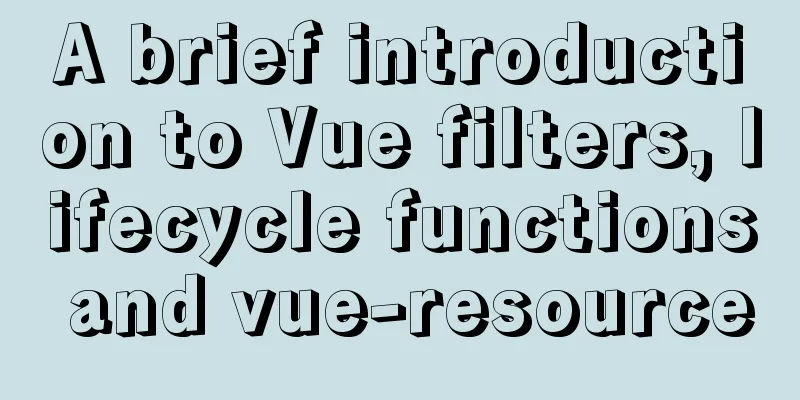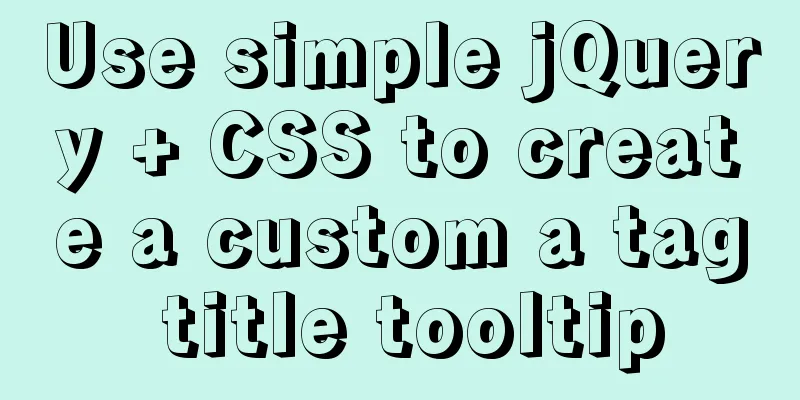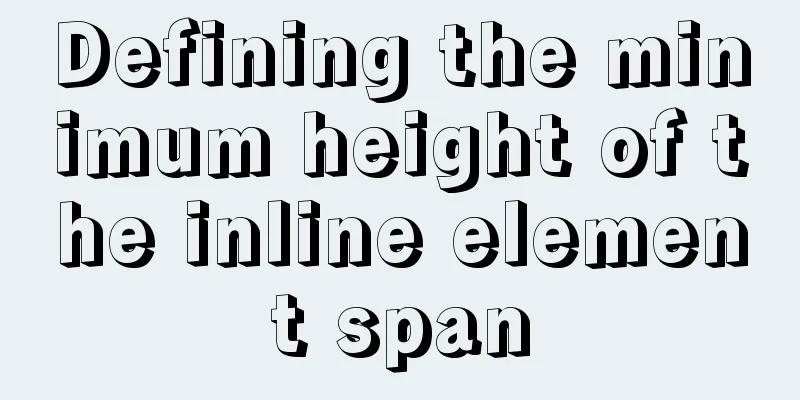A brief introduction to Vue filters, lifecycle functions and vue-resource

1. FilterExample:
<!DOCTYPE html>
<html lang="en">
<head>
<meta charset="UTF-8">
<title>Title</title>
<script src="vue.js"></script>
</head>
<body>
<div id="app">
//Replace the abc in the content of msg with 'Hello 123', and finally add '========'
<p>{{ msg | msgFormat('Hello', '123') | test }}</p>
</div>
<script>
// Define a Vue global filter named msgFormat
Vue.filter('msgFormat', function (msg, arg, arg2) {
// string replace method, the first parameter, in addition to writing a string, can also define a regular return msg.replace(/abc/g, arg + arg2)
})
Vue.filter('test', function (msg) {
return msg + '========'
})
// Create a Vue instance and get the ViewModel
var vm = new Vue({
el: '#app',
data: {
msg: 'abc,abcdefg,hahaha'
},
methods: {}
});
</script>
</body>
</html>
2. Vue's life cycle function 1. What is the life cycleFrom the creation, operation, to the destruction of a Vue instance, there are always various events, which are collectively called the life cycle. 2. Main life cycle function classification 1. Life cycle functions during creation: 2. Life cycle functions during operation: 3. Life cycle functions during destruction: Example:
<!DOCTYPE html>
<html lang="en">
<head>
<meta charset="UTF-8">
<title>Title</title>
<script src="vue.js"></script>
</head>
<body>
<div id="app">
<input type="button" value="Modify msg" @click="msg='No'">
<h3 id="h3">{{ msg }}</h3>
</div>
<script>
var vm = new Vue({
el: '#app',
data: {
msg: 'ok'
},
methods: {
show() {
console.log('show method executed')
}
},
beforeCreate() {
alert('beforeCreate1')
//this.show()
// Note: When the beforeCreate lifecycle function is executed, the data in data and methods have not been initialized yet},
created() { // This is the second life cycle function encountered alert('created2')
// this.show()
// In create, data and methods have been initialized!
// If you want to call the methods in methods, or operate the data in data, at first, you can only operate in create},
beforeMount() { // This is the third lifecycle function encountered, indicating that the template has been edited in memory, but the template has not yet been rendered to the page alert('beforeMount3')
// When beforeMount is executed, the elements in the page have not been actually replaced, just some template strings written before},
mounted() { // This is the fourth lifecycle function encountered, indicating that the template in memory has been actually mounted to the page, and the user can already see the rendered page alert('mounted4')
// Note: mounted is the last lifecycle function during instance creation. When mounted is executed, it means that the instance has been completely created. At this time, if there is no other operation, this instance will lie quietly in our memory, motionless},
// Next are two running events beforeUpdate() { // At this time, it means that our interface has not been updated [Has the data been updated? The data has definitely been updated.
alert('beforeUpdate modification')
// Conclusion: When executing beforeUpdate, the data displayed in the page is still old. At this time, the data is the latest, and the page has not yet been synchronized with the latest data},
updated() {
console.log('The content of the element on the interface:' + document.getElementById('h3').innerText)
console.log('The msg data in data is:' + this.msg)
// When the updated event is executed, the page and data are synchronized and are all up to date}
})
</script>
</body>
</html> 3. vue-resourceGitHub address: https://github.com/pagekit/vue-resource 1. The request API of vue-resource is designed in the REST style. It provides 7 request APIs
2. Parameter introduction All accept three parameters: data (optional, string or object), the data to be sent, which can be overridden by the data attribute in the options object. options object Parameter Type Description url string The requested URL method string HTTP method of the request, for example: 'GET', 'POST' or other HTTP methods body Object, FormData string request body params Object Request URL parameter object, get headers Object request header Third-party request data requires timeout number Request timeout in milliseconds (0 means no timeout) before function(request) The processing function before the request is sent, similar to jQuery's beforeSend function progress function(event) ProgressEvent callback processing function credentials boolean Indicates whether credentials are required for cross-domain requests emulateHTTP boolean Send PUT, PATCH, DELETE requests as HTTP POST and set the request header's X-HTTP-Method-Override emulateJSON boolean Send the request body as application/x-www-form-urlencoded content type 3. Examples
<!DOCTYPE html>
<html lang="en">
<head>
<meta charset="UTF-8">
<title>Title</title>
<script src="vue.js"></script>
<script src="https://cdn.jsdelivr.net/npm/vue-resource"></script>
</head>
<body>
<div id="app">
<input type="button" value="get request" @click="getInfo">
<input type="button" value="post request" @click="postInfo">
<input type="button" value="jsonp request" @click="jsonpInfo">
</div>
<script>
// Create a Vue instance and get the ViewModel
var vm = new Vue({
el: '#app',
data: {},
methods: {
getInfo() { // Initiate a get request // After initiating a get request, use .then to set the successful callback function this.$http.get('http://vue.studyit.io/api/getlunbo').then(function (result) {
// Get the successful data returned by the server through result.body // console.log(result.body)
})
},
postInfo() { // Initiate a post request application/x-wwww-form-urlencoded
// Manually initiated Post request, by default there is no form format, so some servers cannot handle it // Through the third parameter of the post method, { emulateJSON: true } sets the submitted content type to the normal form data format this.$http.post('http://vue.studyit.io/api/post', {}, { emulateJSON: true }).then(result => {
console.log(result.body)
})
},
jsonpInfo() { // Initiate JSONP request this.$http.jsonp('http://vue.studyit.io/api/jsonp').then(result => {
console.log(result.body)
})
}
}
});
</script>
</body>
</html>
The above is a brief introduction to Vue filters, lifecycle functions and vue-resource. For more information about Vue filters, lifecycle functions and vue-resource, please pay attention to other related articles on 123WORDPRESS.COM! You may also be interested in:
|
<<: Detailed explanation of template tag usage (including summary of usage in Vue)
>>: Example of using js to natively implement year carousel selection effect
Recommend
Vue implements a simple shopping cart example
This article example shares the specific code of ...
Detailed explanation of MySQL database--multi-table query--inner join, outer join, subquery, correlated subquery
Multi-table query Use a single select statement t...
HTML realizes real-time monitoring function of Hikvision camera
Recently the company has arranged to do some CCFA...
JavaScript+HTML to implement student information management system
Table of contents 1. Introduction 2. Rendering 3....
How to use Gitlab-ci to continuously deploy to remote machines (detailed tutorial)
Long story short, today we will talk about using ...
Vue implements the product tab of the product details page function
This article example shares the specific code of ...
How to install Oracle on Windows Server 2016
1. Install Oracle There are too many Oracle insta...
How to build SFTP server and image server on Linux cloud server
First of all, you can understand the difference b...
JavaScript to achieve magnifying glass effect
This article shares the specific code for JavaScr...
How to test the maximum number of TCP connections in Linux
Preface There is a misunderstanding about the max...
Detailed description of the function of meta name="" content="
1. Grammar: <meta name="name" content...
How to implement parent-child component communication with Vue
Table of contents 1. Relationship between parent ...
Completely uninstall mysql. Personal test!
Cleanly uninstall MySQL. Personally tested, this ...
Implementation of CSS3 3D cool cube transformation animation
I love coding, it makes me happy! Hello everyone,...
Introduction to MySQL database performance optimization
Table of contents Why optimize? ? Where to start?...









